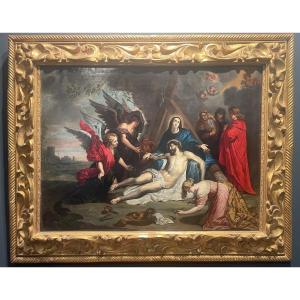Giovan Battista Salvi known as 'il Sassoferrato' (1609 - 1685) circle/ workshop
Madonna with sleeping child
Oil on canvas
84 x 66 cm - Framed (19th century) 112 x 95 cm
All the details relating to this painting can be viewed at the following - LINK -
The painting presented here, executed in the second half of the 17th century with a good quality of execution and refined draftsmanship, depicts the Madonna in adoration as she gently holds the sheet on which the sleeping Child is lying, with a gesture of protection and pride, facilitating an atmosphere of intimate recollection.
The compositional prototype was conceived by the great Bolognese School leader Guido Reni (1575 - 1642), as evidenced by a print made by Francois de Poilly (Paris 1623-1693) (https://www.metmuseum.org/art/collection/search/667926). Like many of Reni's creations, it was later taken up and popularised by later versions executed by his pupils and followers, such as the 'Madonna and Child' attributed to Francesco Gessi (Bologne, 1588 - 1649) and now in the Louvre (https://collections.louvre.fr/ark:/53355/cl010061140).
This subject, albeit with some variations - often of the pose of the sleeping child, facing upwards as in this version, rather than reclining to the side or of the position of the Virgin, with her hands folded in prayer - was so successful that it became the preferred model for countless works destined for private devotion during the 17th century.
One of the greatest promulgators of the Rhenish images was undoubtedly Giovan Battista Salvi known as 'il Sassoferrato' (1609 - 1685) who, in his flourishing workshop, took up the subjects but reworked them with his own, clearly identifiable style, characterised by a marked elegance, gentleness and formal perfection, particularly of the faces, succeeding in achieving an effect of incredible intensity.
Born in Marchigiano, Salvi developed his activity in Rome, following the dictates of the classicist sacred painting of the Bolognese school of Reni, Carracci and Domenichino, but managing to have an autonomous and therefore clearly distinguishable style. The Madonnas that came out of his workshop, with the paleness of their faces and the bright colour of their cloaks, the sweetness of their gazes and the gracefulness of their features, were to provide inspiration for the Pre-Raphaelites and numerous other 19th century artists two centuries later.
Our canvas is in a good state of preservation, although it does have some old retouches and minor pictorial faults, as can be seen from the published photographs, but these do not detract from its beauty. The work is completed by an attractive 19th century wooden frame.
ADDITIONAL INFORMATION:
The work is sold with a certificate of authenticity and descriptive iconographic card.
We take care of and organise the transport of the purchased works, both for Italy and abroad, through professional and insured carriers.
Should you have the desire to see this or other works in person, we will be happy to welcome you to our new gallery in Riva del Garda, Viale Giuseppe Canella 18. We look forward to seeing you!
In case of purchase of the work by non-Italian customers, it will be necessary to obtain an export permit, which takes about 10/20 days; our gallery will take care of the whole phase until it is obtained. All costs of this operation are included.
Contact us for any information, we will be happy to answer you.
Follow us also on :
https://www.instagram.com/galleriacastelbarco/?hl=it
https://www.facebook.com/galleriacastelbarco/


















































 Le Magazine de PROANTIC
Le Magazine de PROANTIC TRÉSORS Magazine
TRÉSORS Magazine Rivista Artiquariato
Rivista Artiquariato